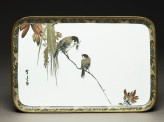Meiji Arts trail
Japanese spirit, Western technology; explore the changing styles and techniques of Meiji decorative arts.
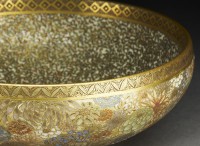
- This is a visual browsing tool that maps objects in this publication, gallery or collection trail by date of creation onto a timeline.
- The circular markers indicate where objects are on the timeline.
- The size of the markers indicates the relative number of objects at that point on the timeline.
- Hover over a marker to find out which objects are represented at that point in time.
- To expand, collapse or hide the timeline, click these symbols
 found at the top right of the timeline.
found at the top right of the timeline.
- 1870
- 1880
- 1890
- 1900
- 1910
- 1920
- 1930
- 1940
Cloisonné enamel
Unlike other crafts that flourished during the Meiji period, the art of cloisonné enamelling was not already widespread in Japan during the Edo period. The making of larger, three-dimensional objects only began from the 1830s.
Development of cloisonné
The craft developed slowly at first and until the 1870s the colours were poor and the execution crude. During the Meiji period, however, technological innovations from the West vastly improved the standard of work and cloisonné became a popular export item.
Cloisonné enamel is made by fusing powdered glass onto a copper or other metal body. The colours are separated using strips of metal, called cloisons, which outline the picture or pattern to be formed. Repeated firing in a kiln and a long polishing process were required to obtain the smooth surface characteristic of the finest cloisonné.
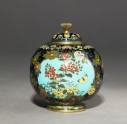 Circular jarlet with flowers and butterflies (EA1993.39)
Circular jarlet with flowers and butterflies (EA1993.39)
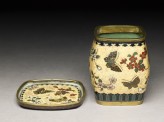 Tobacco jar and stand with butterflies and flowers (EA1995.151)
Tobacco jar and stand with butterflies and flowers (EA1995.151)
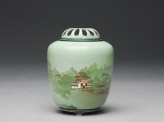 Incense burner, or kōro, with an entrance gate amid trees (EA2000.180)
Incense burner, or kōro, with an entrance gate amid trees (EA2000.180)
Namikawa Yasuyuki (1845-1927)
There were two significant enamellers working in Japan at this time; Namikawa Yasuyuki and Namikawa Sōsuke. Both were appointed as Imperial Craftsmen but employed quite different styles and techniques. Namikawa Yasuyuki (1845-1927) was skilled at using wire to create detailed pictures and patterns, and at covering large areas with a flawless, opaque enamel in a single colour.
 Baluster vase with wisteria and birds (EA1988.1)
Baluster vase with wisteria and birds (EA1988.1)
 Vase with chrysanthemums and a butterfly (EA2000.48)
Vase with chrysanthemums and a butterfly (EA2000.48)
 Vase with waterfall over rocks (EA2002.177)
Vase with waterfall over rocks (EA2002.177)
Namikawa Sōsuke (1847-1910)
In contrast, Namikawa Sōsuke (1847-1910) focused more on the creating the look of painted decoration by hiding or removing the cloisons. He collaborated with artists by recreating their painted pictures in enamel and in these cases the image often has the signature of the painter, and the object itself has Namikawa Sōsuke's seal.
Innovative techniques
From about 1900, new techniques were incorporated into Japanese cloisonné enamel work. Moriage is a method of building up the wire cloisons to create raised, three-dimensional areas of detail in the deecoration. Another technique, plique-a-jour, involved the removal of the metal body onto which the cloisonné enamel had been applied leaving an extremely fragile piece consisting of only the cloisons and transparent enamel. This was first invented in France and introduced to Japanese enamellers at the Paris Exposition in 1900.
© 2013 University of Oxford - Ashmolean Museum

